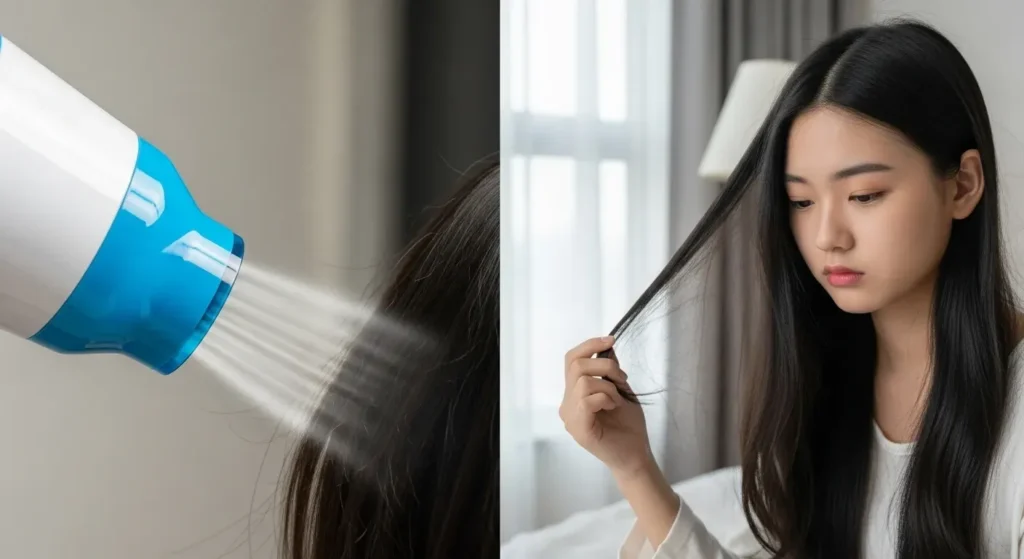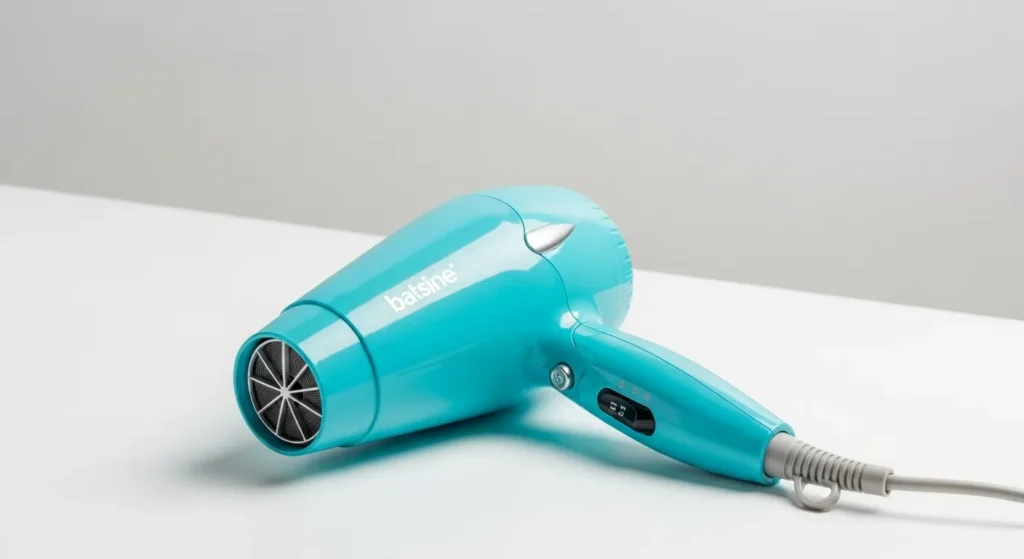Worried that your daily blow-drying habit might be causing hair loss? You’re not alone. Many people wonder: does hair dryer cause hair loss, or is it just another beauty myth?
In this blog, we’ll uncover the science behind heat styling, share dermatologist-backed advice, and offer safe hair care tips. You’ll walk away with clarity, confidence, and expert knowledge to protect your hair, without giving up your favorite styling tool.

Can Using a Hair Dryer Lead to Hair Loss?
Blow drying doesn’t directly cause permanent hair loss, but it can contribute to hair breakage, which many mistake for shedding or thinning.
What Happens When You Blow Dry Wet Hair
When your hair is wet, it’s in its most fragile state. Exposing it immediately to high heat can cause the outer cuticle layer to crack, leading to frizz, split ends, and brittle strands.
Hair Fall vs. Hair Breakage: What’s the Difference?
- Hair fall originates at the root—it’s often related to hormones, stress, or medical conditions.
- Breakage, on the other hand, happens along the hair shaft due to physical or chemical damage, like heat.
Important: Breakage can mimic thinning, but it’s usually reversible with care and technique adjustments.
Does Blow Drying Damage Hair Follicles or Just Strands?
Hair dryers don’t affect the follicles unless used too close to the scalp or excessively on high heat. Chronic scalp burns or inflammation, though rare, could impact follicular health.
How Heat Affects Your Hair and Scalp
Cuticle Damage and Moisture Loss
The cuticle is the hair’s outer protective layer. High heat lifts and weakens it, allowing moisture to escape. This leads to dry, dull, and frizzy hair that’s prone to snapping.
Signs of Heat-Damaged Hair
- Dull appearance and rough texture
- Split ends and mid-shaft breakage
- Increased tangling and frizz
- Lack of elasticity when wet
Impact on Scalp Health and Sebum Balance
Blow drying too close to the scalp can strip natural oils, leaving the scalp dry, itchy, or flaky—conditions that can indirectly affect overall hair health.
ABHRS Guidelines on Hair Dryer Usage
While no formal restriction exists, ABHRS-affiliated physicians generally advise:
- Use moderate heat
- Maintain a distance from the scalp
- Avoid daily heat exposure, especially post-surgery or hair treatment
Common Blow-Drying Mistakes That Can Lead to Damage

- Using Maximum Heat Too Often: High heat can rapidly dehydrate strands.
- Holding the Dryer Too Close: Keep at least 6–8 inches away from the scalp.
- Blow Drying Soaking Wet Hair Without Towel-Drying First: Excess moisture increases the risk of damage.
- Skipping Heat Protectants or Serums: These products form a barrier against thermal stress.
Pro Tip: Always start with the lowest heat setting and work up only if needed.
Best Practices for Safe Hair Dryer Use
Recommended Temperature Settings
- Fine or thin hair: Use the cool or low heat setting.
- Thick or coarse hair: Medium heat is acceptable with a protectant.
Maintain Distance and Movement
Avoid focusing heat on one spot—move the dryer in constant motion to prevent overheating.
Use of Cool Air Features and Ionic Technology
Cool air settings help seal the cuticle post-drying. Ionic dryers reduce drying time and frizz by breaking down water molecules efficiently.
Frequency Guidelines for Blow Drying Hair Safely
Limit heat styling to 2–3 times a week. Let your hair air-dry partially before finishing with the dryer.
Other Possible Causes of Hair Loss You Might Be Overlooking
While blow drying can contribute to hair damage, actual loss often stems from:
- Genetic and Hormonal Factors (e.g., androgenetic alopecia)
- Nutritional Deficiencies like iron, vitamin D, or biotin
- Stress and scalp inflammation
- Chemical Treatments like bleaching, perming, or straightening
- Tight Hairstyles that pull on the hair root (traction alopecia)
How to Protect Your Hair if You Use a Hair Dryer Regularly
Weekly Deep Conditioning Treatments
Use protein masks or hydrating treatments once a week to restore moisture and repair damage.
Leave-in Products for Heat Protection
Look for sprays or serums with thermal shielding up to 450°F.
Choosing the Right Hair Dryer for Your Hair Type
- Ionic dryers: Reduce static and frizz
- Ceramic dryers: Provide even heat for sensitive hair
- Tourmaline dryers: Ideal for thick, frizzy hair types
FAQs – Hair Dryers and Hair Loss
Is it bad to use a hair dryer every day?
Daily use on high heat can cause cumulative damage. Limit usage and incorporate rest days.
Which is better: air drying or blow drying?
Air drying is gentler, but controlled blow drying with protection is safe for most people.
Can cold air still damage hair?
Cold air won’t damage hair, but it won’t dry as efficiently. It’s safest post-styling to reduce frizz.
What’s the safest way to dry your hair fast?
Towel-dry gently, use medium heat with a protectant, and don’t focus the dryer on one area too long.
Final Thoughts: Does Blow Drying Cause Hair Loss?
Blow drying doesn’t cause hair loss, but it can contribute to hair breakage, dryness, and frizz if used improperly. By using the right temperature, technique, and protectants, you can style your hair safely without fear of permanent damage.
Remember: It’s not about avoiding blow dryers—it’s about using them smartly.
Talk to a Hair Loss Specialist Today
Worried your styling habits are damaging your hair? Book a consultation with Dr. Rana Irfan in Islamabad for expert evaluation and a personalized hair care plan. With decades of experience in restoring healthy hair, Dr. Irfan can help you prevent further damage and regain your confidence.
